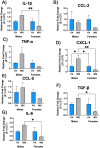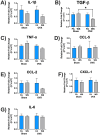Neuroinflammation is dependent on sex and ovarian hormone presence following acute woodsmoke exposure
- PMID: 38844478
- PMCID: PMC11156661
- DOI: 10.1038/s41598-024-63562-2
Neuroinflammation is dependent on sex and ovarian hormone presence following acute woodsmoke exposure
Abstract
Woodsmoke (WS) exposure is associated with significant health-related sequelae. Different populations can potentially exhibit varying susceptibility, based on endocrine phenotypes, to WS and investigating neurological impacts following inhaled WS is a growing area of research. In this study, a whole-body inhalation chamber was used to expose both male and female C57BL/6 mice (n = 8 per group) to either control filtered air (FA) or acute WS (0.861 ± 0.210 mg/m3) for 4 h/d for 2 days. Neuroinflammatory and lipid-based biological markers were then assessed. In a second set of studies, female mice were divided into two groups: one group was ovariectomized (OVX) to simulate an ovarian hormone-deficient state (surgical menopause), and the other underwent Sham surgery as controls, to mechanistically assess the impact of ovarian hormone presence on neuroinflammation following FA and acute WS exposure to simulate an acute wildfire episode. There was a statistically significant impact of sex (P ≤ 0.05) and statistically significant interactions between sex and treatment in IL-1β, CXCL-1, TGF-β, and IL-6 brain relative gene expression. Hippocampal and cortex genes also exhibited significant changes in acute WS-exposed Sham and OVX mice, particularly in TGF-β (hippocampus) and CCL-2 and CXCL-1 (cortex). Cortex GFAP optical density (OD) showed a notable elevation in male mice exposed to acute WS, compared to the control FA. Sham and OVX females demonstrated differential GFAP expression, depending on brain region. Overall, targeted lipidomics in phosphatidylcholine (PC) and phosphatidylethanolamine (PE) serum and brain lipids demonstrated more significant changes between control FA and acute WS exposure in female mice, compared to males. In summary, male and female mice show distinct neuroinflammatory markers in response to acute WS exposure. Furthermore, ovarian hormone deficiency may impact the neuroinflammatory response following an acute WS event.
Keywords: Inflammation; Inhalation; Menopause; Sex-differences; Toxicology; Wildfire.
© 2024. The Author(s).
Conflict of interest statement
The authors declare no competing interests.
Figures








References
-
- Casey JA, Kioumourtzoglou M-A, Elser H, Walker D, Taylor S, Adams S, Aguilera R, Benmarhnia T, Catalano R. Wildfire particulate matter in Shasta County, California and respiratory and circulatory disease-related emergency department visits and mortality, 2013–2018. Environ. Epidemiol. 2021;5:e124–e127. doi: 10.1097/EE9.0000000000000124. - DOI - PMC - PubMed
-
- Rooney MS, Arku RE, Dionisio KL, Paciorek C, Friedman AB, Carmichael H, Zhou Z, Hughes AF, Vallarino J, Agyei-Mensah S. Spatial and temporal patterns of particulate matter sources and pollution in four communities in Accra, Ghana. Sci. Total Environ. 2012;435:107–114. doi: 10.1016/j.scitotenv.2012.06.077. - DOI - PubMed
MeSH terms
Grants and funding
- P42 ES025589/ES/NIEHS NIH HHS/United States
- R00 ES029104/NH/NIH HHS/United States
- R21 ES032432/NH/NIH HHS/United States
- R01 ES033981/NH/NIH HHS/United States
- R01 ES033981/ES/NIEHS NIH HHS/United States
- S10 OD032292/OD/NIH HHS/United States
- P30 ES032755/ES/NIEHS NIH HHS/United States
- P20 GM130422/GM/NIGMS NIH HHS/United States
- T32 GM144834/GM/NIGMS NIH HHS/United States
- K12 GM088021/GM/NIGMS NIH HHS/United States
- R21 ES032432/ES/NIEHS NIH HHS/United States
- R00 ES029104/ES/NIEHS NIH HHS/United States
- S10 RR027926/RR/NCRR NIH HHS/United States
LinkOut - more resources
Full Text Sources
Miscellaneous

